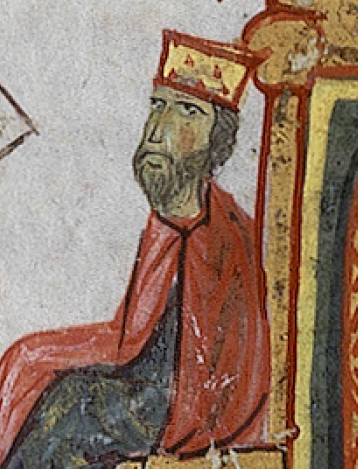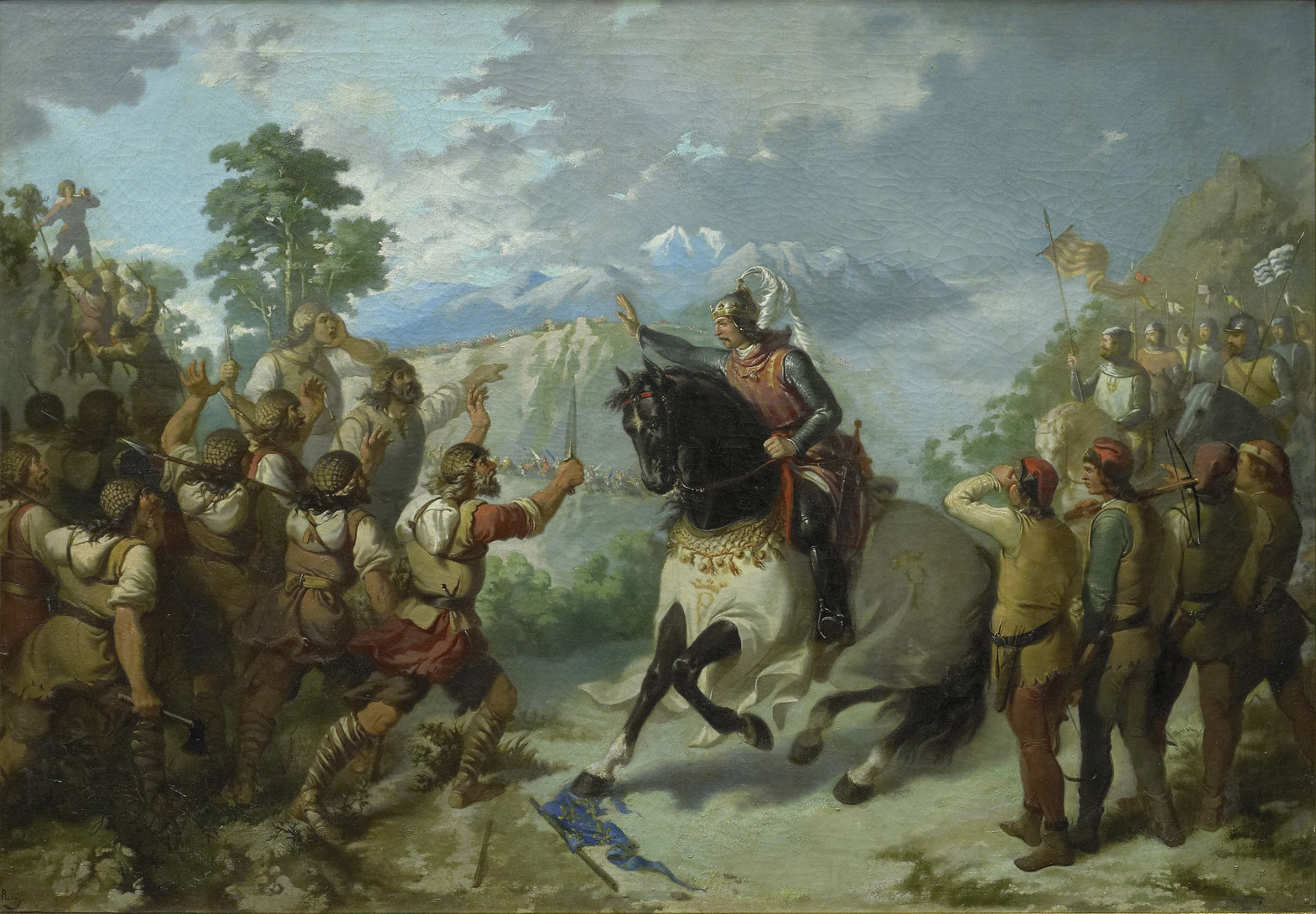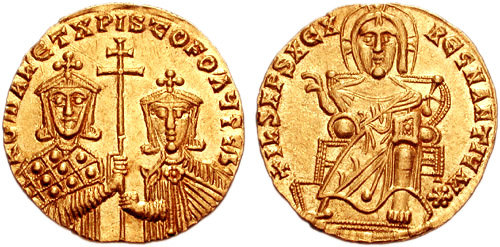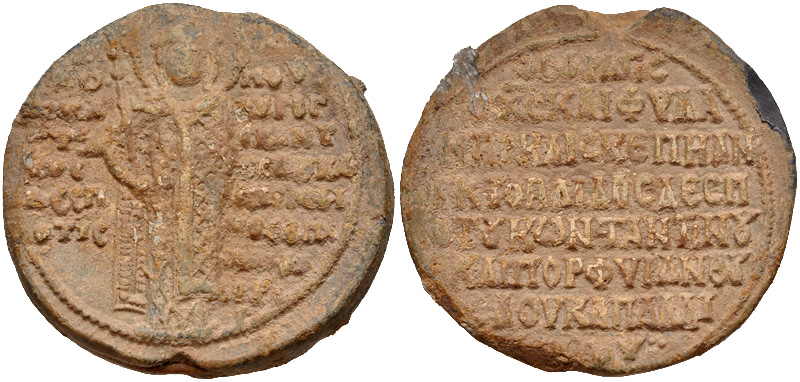|
Mouzalon Family
Mouzalon or Muzalon ( el, Μουζάλων, pl. Μουζάλωνες) was the name of a Byzantine family attested in the 11th through 15th centuries, which produced a number of officials and high dignitaries. The family reached its peak in the 1250s, when it enjoyed the patronage of Emperor Theodore II Laskaris (r. 1254–1258), but was largely purged after his death by the great aristocratic families. The female form of the name is Mouzalonissa (Μουζαλώνισσα). History and members The first known members of the family are attested in 11th-century seals. One of them records Theophano Mouzalonissa, "''archontissa'' of '' Rhousia''". It has been suggested that she was the wife of Oleg Svyatoslavovich, lord of Tmutarakan, but it is also possible that she was simply the wife of the Byzantine ''archon'' of the port city and base of ''Rhosia'', which was located near Tmutarakan. In the late 11th century, Nicholas Mouzalon, became Archbishop of Cyprus and later, in 1147–1151 ... [...More Info...] [...Related Items...] OR: [Wikipedia] [Google] [Baidu] |
Byzantine
The Byzantine Empire, also referred to as the Eastern Roman Empire or Byzantium, was the continuation of the Roman Empire primarily in its eastern provinces during Late Antiquity and the Middle Ages, when its capital city was Constantinople. It survived the fragmentation and fall of the Western Roman Empire in the 5th century AD and continued to exist for an additional thousand years until the fall of Constantinople to the Ottoman Empire in 1453. During most of its existence, the empire remained the most powerful economic, cultural, and military force in Europe. The terms "Byzantine Empire" and "Eastern Roman Empire" were coined after the end of the realm; its citizens continued to refer to their empire as the Roman Empire, and to themselves as Romans—a term which Greeks continued to use for themselves into Ottoman times. Although the Roman state continued and its traditions were maintained, modern historians prefer to differentiate the Byzantine Empire from Ancient Rome a ... [...More Info...] [...Related Items...] OR: [Wikipedia] [Google] [Baidu] |
Michael VIII Palaiologos
Michael VIII Palaiologos or Palaeologus ( el, Μιχαὴλ Δούκας Ἄγγελος Κομνηνὸς Παλαιολόγος, Mikhaēl Doukas Angelos Komnēnos Palaiologos; 1224 – 11 December 1282) reigned as the co-emperor of the Empire of Nicaea from 1259 to 1261, and as Byzantine emperor from 1261 until his death in 1282. Michael VIII was the founder of the Palaiologan dynasty that would rule the Byzantine Empire until the Fall of Constantinople in 1453. He recovered Constantinople from the Latin Empire in 1261 and transformed the Empire of Nicaea into a restored Byzantine Empire. His reign saw considerable recovery of Byzantine power, including the enlargement of the Byzantine army and navy. It would also include the reconstruction of the city of Constantinople, and the increase of its population. Additionally, he re-established the University of Constantinople, which led to what is regarded as the Palaiologan Renaissance between the 13th and 15th centuries. It was ... [...More Info...] [...Related Items...] OR: [Wikipedia] [Google] [Baidu] |
Ottomans
The Ottoman Turks ( tr, Osmanlı Türkleri), were the Turkic founding and sociopolitically the most dominant ethnic group of the Ottoman Empire ( 1299/1302–1922). Reliable information about the early history of Ottoman Turks remains scarce, but they take their Turkish name, ''Osmanlı'' ("Osman" became altered in some European languages as "Ottoman"), from the house of Osman I (reigned 1299–1326), the founder of the House of Osman, the ruling dynasty of the Ottoman Empire for its entire 624 years. Expanding from its base in Söğüt, the Ottoman principality began incorporating other Turkish-speaking Muslims and non-Turkish Christians. Crossing into Europe from the 1350s, coming to dominate the Mediterranean Sea and, in 1453, invading Constantinople (the capital city of the Byzantine Empire), the Ottoman Turks blocked all major land routes between Asia and Europe. Western Europeans had to find other ways to trade with the East. Brief history The "Ottomans" first ... [...More Info...] [...Related Items...] OR: [Wikipedia] [Google] [Baidu] |
Battle Of Bapheus
The Battle of Bapheus occurred on 27 July 1302, between a Ottoman army under Osman I and a Byzantine army under George Mouzalon. The battle ended in a crucial Ottoman victory, cementing the Ottoman state and heralding the final capture of Byzantine Bithynia by the Ottomans. Strategic context Osman I had succeeded in the leadership of his clan in c. 1281, and over the next . two decades launched a series of ever-deeper raids into the Byzantine borderlands of Bithynia. By 1301, the Ottomans were besieging Nicaea, the former imperial capital, and harassing Prusa. The Turkish raids also threatened the port city of Nicomedia with famine, as they roamed the countryside and prohibited the collection of the harvest (see Akinji). In the spring of 1302, Emperor Michael IX (r. 1294–1320) launched a campaign which reached south to Magnesia. The Turks, awed by his large army, avoided battle. Michael sought to confront them, but was dissuaded by his generals. The Turks, encouraged, ... [...More Info...] [...Related Items...] OR: [Wikipedia] [Google] [Baidu] |
Hetaireiarches
The ( grc-gre, ἑταιρειάρχης), sometimes anglicized as Hetaeriarch, was a high-ranking Byzantine officer, in command of the imperial bodyguard, the . In the 9th–10th centuries there appear to have been several , each for one of the subdivisions of the , but in later times only the senior of them, the ( grc-gre, μέγας ἑταιρειάρχης) or Great Hetaeriarch survived, eventually becoming simply a high court rank in the 12th–15th centuries. History The Imperial (, ) was a bodyguard regiment of the Byzantine emperors in the 9th–11th centuries, originally recruited mainly from among foreigners. It is first mentioned in 812, as a bodyguard for the emperor on campaign, but its origin is obscure. The Imperial of the 9th–10th centuries was divided in several units: three or four according to the sources, distinguished by their epithets and each, at least originally, under is respective . Thus the commanded the 'Great ' (, ). He was the senior of the mil ... [...More Info...] [...Related Items...] OR: [Wikipedia] [Google] [Baidu] |
Catalan Company
The Catalan Company or the Great Catalan Company (Spanish: ''Compañía Catalana'', Catalan: ''Gran Companyia Catalana'', Latin: ''Exercitus francorum'', ''Societas exercitus catalanorum'', ''Societas cathalanorum'', ''Magna Societas Catalanorum'') was a company of mercenaries led by Roger de Flor in the early 14th century and hired by the Byzantine Emperor Andronikos II Palaiologos to combat the increasing power of the Anatolian beyliks. It was formed by '' almogavar'' veterans of the War of the Sicilian Vespers, who had remained unemployed after the signing in 1302 of the Peace of Caltabellotta between the Crown of Aragon and the French dynasty of the Angevins. Origin The military demands of the Reconquista stimulated the formation of the elite light infantry known as the ''almogavars'' on the Iberian peninsula during the 13th century. These troops were used quite effectively by the Crown of Aragon for other imperial ventures in the Mediterranean, particularly the War of the ... [...More Info...] [...Related Items...] OR: [Wikipedia] [Google] [Baidu] |
Megas Droungarios Tou Ploimou
The ''droungarios'' of the Fleet ( el, δρουγγάριος τοῦ πλοΐμου/τῶν πλοΐμων, ''droungarios tou ploïmou/tōn ploïmōn''; after the 11th century δρουγγάριος τοῦ στόλου, ''droungarios tou stolou''), sometimes anglicized as Drungary of the Fleet, was the commander of the Imperial Fleet (βασιλικὸς στόλος, ''basilikos stolos'', or βασιλικὸν πλόϊμον, ''basilikon ploïmon''), the central division of the Byzantine navy stationed at the capital of Constantinople, as opposed to the provincial ( thematic) fleets. From the late 11th century, when the Byzantine fleets were amalgamated into a single force under the '' megas doux'', the post, now known as the Grand ''droungarios'' of the Fleet (μέγας δρουγγάριος τοῦ στόλου, ''megas droungarios tou stolou''), became the second-in-command of the ''megas doux'' and continued in this role until the end of the Byzantine Empire. Backgroun ... [...More Info...] [...Related Items...] OR: [Wikipedia] [Google] [Baidu] |
Constantine Palaiologos (son Of Andronikos II)
Constantine Doukas Komnenos Palaiologos ( gr, Κωνσταντῖνος Δούκας Κομνηνός Παλαιολόγος; 1278/81–1334/35) was a Byzantine prince of the Palaiologos dynasty, who received the supreme title of Despot and served as provincial governor. Constantine was the second son of Emperor Andronikos II Palaiologos (r. 1282–1328) and his first wife, Empress Anna of Hungary. He was born sometime between 1278 and 1281. As his father was already a reigning co-emperor alongside Michael VIII Palaiologos, he was styled a ''porphyrogennetos'' ("purple-born"), as attested on his seals. In 1294 he was named Despot, the highest court rank in the Byzantine Empire, on the occasion of his first marriage to Eudokia, the daughter of Theodore Mouzalon. In 1305, he fought in the disastrous Battle of Apros against the Catalan Company. In 1317, he intercepted his half-sister Simonida, the queen-consort of Serbia, who wished to retire to a monastery after the death of ... [...More Info...] [...Related Items...] OR: [Wikipedia] [Google] [Baidu] |
Andronikos II Palaiologos
, image = Andronikos II Palaiologos2.jpg , caption = Miniature from the manuscript of George Pachymeres' ''Historia'' , succession = Byzantine emperor , reign = 11 December 1282 –24 May 1328 , coronation = 8 November 1272 , cor-type1 = Coronation , regent = Michael IX Palaiologos , reg-type = Co-emperor , predecessor = Michael VIII Palaiologos (alone) , successor = Andronikos III Palaiologos , spouse = Anna of HungaryYolande of Montferrat , issue = Michael IX PalaiologosConstantine Palaiologos John PalaiologosTheodore I, Marquis of MontferratDemetrios Palaiologos Simonis (Simonida Nemanjić), Queen of SerbiaIrene Palaiologina (wife of John II Doukas), Sebastokratorissa of Thessaly , issue-link = #Family , issue-pipe = more... , dynasty = Palaiologos , father = Michael VIII Palaiologos , mother = Theodora Palaiologina , birth_date = 25 March 1259 , birth_place = Nicaea, Empire of Nicaea( ... [...More Info...] [...Related Items...] OR: [Wikipedia] [Google] [Baidu] |
Second Council Of Lyon
:''The First Council of Lyon, the Thirteenth Ecumenical Council, took place in 1245.'' The Second Council of Lyon was the fourteenth ecumenical council of the Roman Catholic Church, convoked on 31 March 1272 and convened in Lyon, Kingdom of Arles (in modern France), in 1274. Pope Gregory X presided over the council, called to act on a pledge by Byzantine emperor Michael VIII to reunite the Eastern church with the West.Wetterau, Bruce. World history. New York: Henry Holt and company. 1994 The council was attended by about 300 bishops, 60 abbots and more than a thousand prelates or their procurators, among whom were the representatives of the universities. Due to the great number of attendees, those who had come to Lyon without being specifically summoned were given "leave to depart with the blessing of God" and of the Pope. Among others who attended the council were James I of Aragon, the ambassador of the Emperor Michael VIII Palaiologos with members of the Greek clergy and the ... [...More Info...] [...Related Items...] OR: [Wikipedia] [Google] [Baidu] |
Logothetes Tou Genikou
The ( gr, λογοθέτης τοῦ γενικοῦ, often called or simply (, 'the general ogothete), and usually rendered in English as the General Logothete, was in charge of the 'general financial ministry', the of the middle Byzantine Empire.. History and functions The was responsible for general taxation and revenue, and also served as a court for financial cases. As such, it broadly fulfilled the tasks of the earlier , although it was mostly derived from the "general department" of the praetorian prefecture. The first attested , the monk Theodotos, is mentioned in 692, but the post may have been instituted as early as 626. The bureau of the and its logothete remained one of the chief ministries for the entire middle Byzantine period (7th–12th centuries). During the Komnenian period, its importance declined, but recovered under the Angeloi. Following the sack of Constantinople in 1204 and the dissolution of the Byzantine Empire, the office of the was retained as ... [...More Info...] [...Related Items...] OR: [Wikipedia] [Google] [Baidu] |
Theodore Mouzalon
Theodore may refer to: Places * Theodore, Alabama, United States * Theodore, Australian Capital Territory * Theodore, Queensland, a town in the Shire of Banana, Australia * Theodore, Saskatchewan, Canada * Theodore Reservoir, a lake in Saskatchewan People * Theodore (given name), includes the etymology of the given name and a list of people * Theodore (surname), a list of people Fictional characters * Theodore "T-Bag" Bagwell, on the television series ''Prison Break'' * Theodore Huxtable, on the television series ''The Cosby Show'' Other uses * Theodore (horse), a British Thoroughbred racehorse * Theodore Racing Theodore Racing ( zh, t=徳利賽車隊香港) was a Formula One constructor from Hong Kong founded by real estate magnate and millionaire Teddy Yip. They participated in 51 grands prix, entering a total of 64 cars. In the present day Theodor ..., a Formula One racing team See also * Principality of Theodoro, a principality in the south-west Crimea from the 13 ... [...More Info...] [...Related Items...] OR: [Wikipedia] [Google] [Baidu] |






